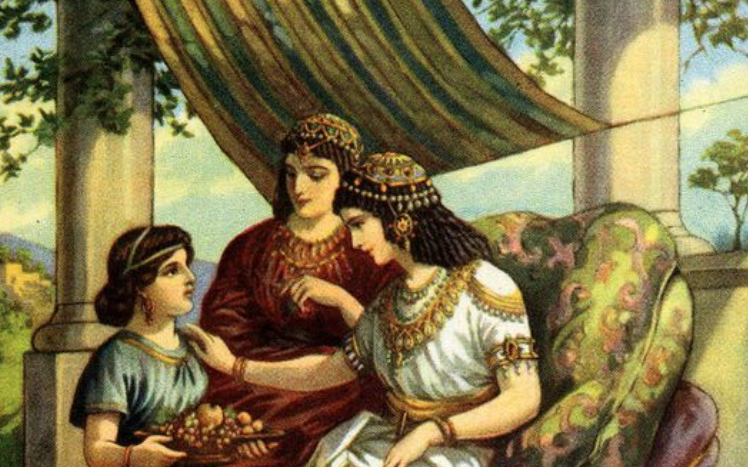
Naaman was the captain of the army of the king of Syria. He was very important to his king because the Lord used him to lead Syria to victory. Naaman was a great and powerful man, but he was also sick with leprosy. The Syrian army sent many groups of soldiers to fight in Israel. One time they took a little girl from the land of Israel. This girl became a servant of Naaman’s wife. She said to his wife, “I wish that my master would meet the prophet who lives in Samaria. He could heal Naaman of his leprosy.” Naaman went to the king and told him what the Israelite girl said. Then the king of Syria said, “Go now, and I will send a letter to the king of Israel.”
In 2 Kings 5, we are introduced to a nameless young child—a young girl kidnapped and enslaved by the Syrians during an attack on Israel. The young girl became a servant of yet another nameless woman—the wife of Naaman, the “very important” captain of the Syrian army. Naaman is clearly a hero of the Syrian empire. The English Standard Version of the Bible describes him as “a mighty man of valor.” As a mighty man, Naaman was everything the little girl was not: adult, male, powerful, privileged, and free. In contrast, the little girl—a mere child, and a female, powerless, marginalized, and enslaved child at that—“is multiply disempowered,” as Laurel Koepf writes in Text, Image, and Otherness in Children’s Bibles: What Is in the Picture? Yet it was the little girl who saved the mighty man.
See, Naaman was not only a mighty man. He was beautiful. Or, he once was beautiful. His name in the narrative comes from the Hebrew verb נָעֵם, naem, which means “to be pleasant, delightful, or lovely.” Biblical commentator J. Hampton Keathley, III says, “His name suggests he had undoubtedly been a handsome man, at least before the leprosy.” While his physical appearance once lived up to his name, when we are introduced to Naaman that is no longer the case. In a tragic irony, this mighty man of beauty was now inflicted with—of all diseases—leprosy. Leprosy destroyed one’s physical beauty. It involved spongy tumors, the deterioration of tissue between bones, physical deformities, and—in a gruesome finale—fingers and toes falling off. It was incurable and lasted until the victim died.
As Naaman’s suffering from the leprosy increased, it surely distressed his wife. This can be assumed because the little Israelite slave girl must have noticed her mistress’s distress. And though both she and her mistress lived in a patriarchal, adultist world where children and women remain nameless and faceless—even when they are the heroines of the story—the little girl wanted to help. I think Alice L. Laffey makes an important observation in An Introduction to the Old Testament: A Feminist Perspective: that “the Israelite maid is the first to speak.” That is a bold move for a child, let alone a slave child. She risked everything by speaking up and putting her faith on the line.
Make no mistake, it is faith that drove the young child to stick her neck out and suggest that Namaan consult with Elisha, “the prophet who lives in Samaria.” The girl believed Elisha “could heal Naaman on his leprosy,” but 2 Kings 5 omits an important and relevant fact: Elisha had never healed anyone of leprosy up to that point. Jesus said this centuries later in Luke 4:27: “There were many people with leprosy living in Israel during the time of the prophet Elisha. But none of them were healed; the only one was Naaman. And he was from the country of Syria, not Israel.”
In other words, the little girl had so much faith in Elisha’s God that she believed They could empower Elisha to do something he had never done before: heal a leper. She had so much faith, in fact, that she risked her own life in suggesting it was a possibility. One can only imagine the horrors the little girl would have in store if Elisha failed to heal Naaman.
Naaman was not only powerful and skilled at violence, he also was an angry, rageful person. We see this later in the narrative when Elisha instructed Naaman to wash seven times in the Jordan River to cure his leprosy. Naaman was insulted by both the simplicity of the solution as well as by the fact that the Jordan River was much dirtier than Syrian rivers like Abana and Pharpar. We are told twice that Naaman became angry. In fact, we are told two verses in a row: first, in verse 11—“Naaman became angry and left”; and second, in verse 12—“He was very angry and turned to leave.” If he became furious simply because he disliked the miracle that would cure his leprosy, who knows how rageful he would have become at the powerless slave girl who made a fool of him by suggesting a false prophet.
Yet the child bravely took that risk. She had faith that Elisha and Elisha’s God would perform a miracle. She also took another risk, perhaps an even more dangerous one: in speaking confidently of her own people’s God, she was inherently challenging the gods of the Syrians. The Syrian gods had failed to heal Naaman.
The young girl, therefore, was speaking prophetically against those gods. She was declaring that she believed her people’s God was more powerful. Old Testament scholar Walter Brueggemann refers to the child’s prophetic critique as theological resistance. He writes, “Her rootage that evoked resistance is theological. This is evident in her use of Israel’s traditional vocabulary, ‘the prophet.’ The term is deeply freighted in her utterance.” By asserting Elisha as the prophet, the child is boldly witnessing to her faith. Brueggemann says she is “an explicit, determined witness to YHWH who offers, in this ostensibly Syrian narrative, her bold testimony to YHWH.” He also notes what I mentioned previously: that her confidence in Elisha “is astonishing, because we have no available data that YHWH’s prophet can counteract leprosy.”
Additionally, and also astonishingly, the child embodies a spirit of compassion and kindness. I really like how Heather Farrell, Mormon theologian and writer at Women in the Scriptures, describes this spirit:
This little girl’s faith humbles me. I don’t know if I would personally have had the faith to open my mouth and bear testimony in a strange country, among people who didn’t believe like I did, and especially not to the people who had torn me away from my home and taken me captive. She is an example to me of forgiveness, of compassion, of faith and great courage. Think about the great risk she took in opening her mouth and bearing testimony of the prophet. What if no one listened to her? What if they laughed at her? What if the prophet hadn’t been able to heal Naaman? But she did open her mouth, she didn’t let her fear keep her silent, and God took her little seed of faith and worked mighty miracles with it.
What Farrell says about having the courage and compassion to not only take the risk in speaking up, but to put your life on the line for the very people who ripped you away from those you love the most, is illuminative. This child displayed empathy with Naaman’s pain, even though Naaman’s people are the ones who kidnapped her, and was willing to try to help him. This child is not only a model for us of courage, but a model of kindness as well. As far as we know, she may have hated Naaman. But she was willing to put aside that hate and acknowledge their shared humanity. Regardless of what she felt about him, even if she felt he was her enemy, she wanted her enemy to not be in pain. That is a powerful testimony for anyone, let alone a female child living in an extraordinarily scary situation.
Personally, the saddest part of this story to me is that the little girl vanishes from the narrative after the first paragraph. We are never told what happened to her—What was her name? Was she rewarded? Was she set free? Was she allowed to return home to her Israelite family? We do not know.
The writers of this were not interested in answering such questions. Based on how they wrote the narrative, it seems at first glance they saw Elisha as the hero and Naaman as the noble protagonist (despite his temper). The king of Israel and Gehazi are clearly meant to be the “bad guys”: the former because he—as the very opposite of the little girl—had no faith in Elisha and Elisha’s God’s and the latter because he wanted to use Elisha and Elisha’s God to benefit himself. But the nameless little girl—the person most responsible for all the events that happened—vanishes.
However, it is noteworthy that—in a world where children and women had the same sociopolitical status as slaves and slaves had no rights—the writers of this narrative chose to highlight the role a female slave child played. As Lois Wilson points out in Stories Seldom Told: Biblical Stories Retold for Children & Adults, “A nameless Israelite slave girl made the story happen.” In fact, the narrative’s writers not only highlight it. They make it the anchor for the entire narrative.
What might not obvious in the English translation is that the story contains a number of inclusios. An inclusio is a literary device in which similar thematic materials are used at the beginning and end of a story to “frame” the events. 2 Kings 5 has several of these, revolving around the contrast between the small and the mighty as well as the young and the old. These are highlighted by Laurel Koepf in Text, Image, and Otherness in Children’s Bibles: What Is in the Picture? Koepf describes how Naaman is first introduced as an ish gadol, a “mighty man.” The child is contrasted immediately with him as a na’arah qetannah, a “small girl.” Next, when Elisha instructs Naaman to bathe in the Jordan River, Naaman is offended. As a mighty man, he expected a mighty task. He also expected to bathe in mightier rivers, like the Syrian rivers back home. And when Naaman does bathe in the Jordan River, his leprosy is healed to the point that his skin is like that of a na’ar qaton, a small boy.
One sees the reoccurring theme already. It is a small child who sets into motion a chain of events where a mighty man is figuratively transformed into a small boy. Additionally, the narrative closes on the image of Gehazi — Elisha’s servant boy — receiving the leprosy of Naaman because of his greed. Robin Cohn, feminist theologian at Women of the Bible for Thinkers, notes that, “The same word to describe the ‘little captive girl’ (as most commentators label her) is also used to describe Elisha’s servant Gehazi.” The slave girl is a na’arah; Gehazi is a na’ar, the male version of na’arah.
So we not only see the intentional contrast between the slave girl’s faithfulness to her God and the prophet Elisha with Gehazi’s unfaithfulness to them. We also see that, in contrast to Naaman who is figuratively transformed from a person with leprous, decaying flesh into a small boy, Gehazi is figuratively transformed from a small boy into a person with leprous, decaying flesh.
The writer(s) of the narrative, therefore, frame the entire story around the themes of mighty and small, young and old. And everything begins with the small slave girl, whose actions lead the mighty to become like the small and the young to become like the old. Perhaps that narrative framing is itself a revolutionary act, an act worthy of the child’s courage and bravado. In terms of political power, the little Israelite girl held the least of all the story’s characters. Yet she ultimately wielded the most power and influenced the course of international politics through her bravery and faith. Naaman might have been a mighty man, but in the end it was a mighty girl who saved his life.












